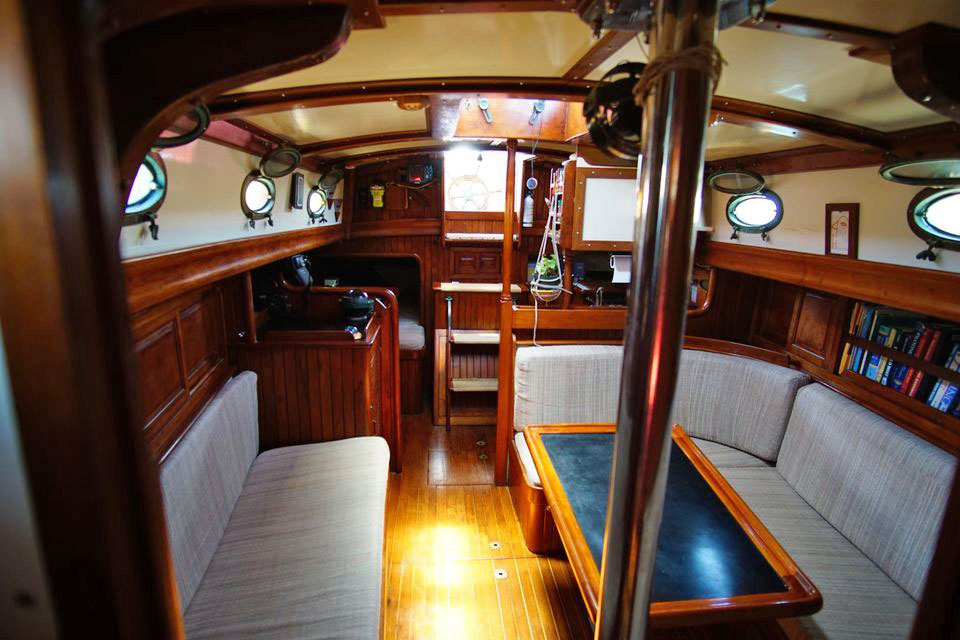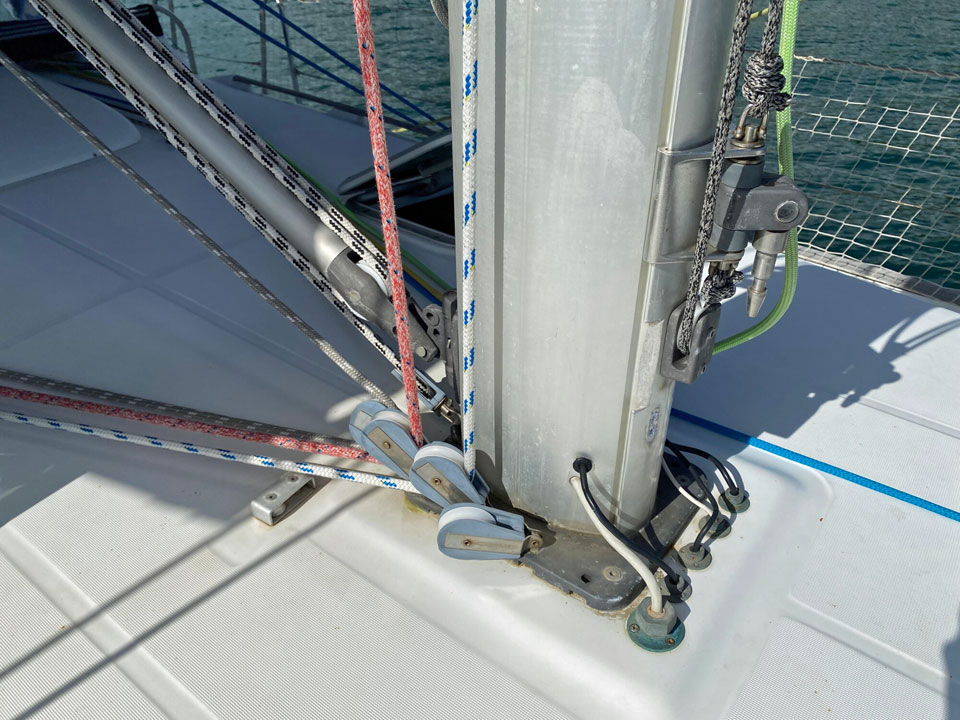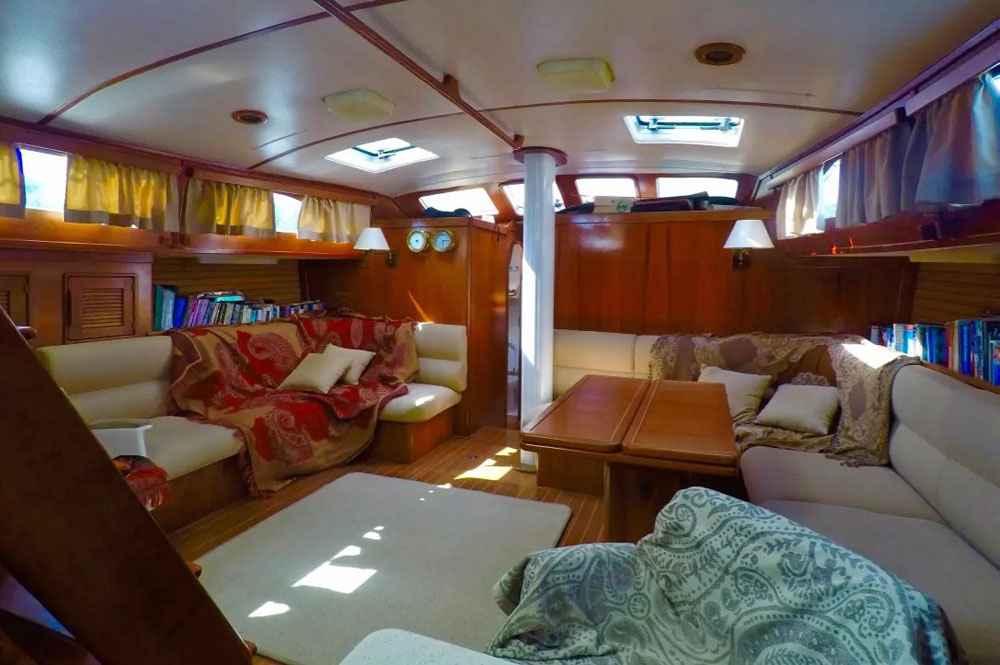Mast Stepping 101: A Guide to Deck-Stepped & Keel-Stepped Masts
In a Nutshell...
The primary difference between a deck-stepped and a keel-stepped mast lies in its structural connection to the boat. A deck-stepped mast sits on the cabin top and is supported by a compression post below, offering easier installation and removal but potentially compromising cabin space. In contrast, a keel-stepped mast passes through the deck and rests directly on the boat's keel or a structural grid, providing superior structural integrity and a more rigid rig, which is a significant advantage for offshore sailing. While a deck-stepped mast is a practical choice for many cruising boats due to its lower cost and easier maintenance, a keel-stepped mast is often preferred by those prioritising performance and ultimate strength.
Table of Contents
A Sailor's Perspective on Mast Design & Performance
As someone who has spent many an offshore watch staring up at a rig, the mast is far more than a spar holding up the sails; it is the backbone of the boat's propulsion system. The choice between a deck-stepped and a keel-stepped mast influences everything from a boat’s handling and performance to its maintenance and interior layout. I've sailed on everything from small cruisers with deck-stepped rigs that made for quick and easy maintenance to larger offshore yachts with keel-stepped masts that inspired immense confidence in heavy seas. Let's delve into the details of both installations.
Deck-Stepped Masts: Practicality & Maintenance
A deck-stepped mast is, as the name suggests, stepped directly onto the deck of the boat. Its compression load is transferred to the keel via a compression post or bulkhead, which is a critical structural element. This design is prevalent on many modern cruising boats and production yachts.
Advantages & Disadvantages of Deck-Stepped Masts
Advantages:
- Ease of Installation & Removal: Mast stepping and unstepping is a far simpler and less expensive process. This is a huge bonus for those who need to de-rig for winter storage or transport.
- Reduced Water Leaks: The mast base is sealed on the deck, eliminating the potential for water leaks where the mast passes through the deck.
- Interior Space: There is no mast passing through the cabin, which can open up the interior layout and create more usable space.
- Cost: Generally less expensive to build and install than a keel-stepped system.
Disadvantages:
- Structural Load: All the compression load is concentrated on the deck and the compression post, which can be a point of failure if not properly engineered and maintained. A poorly maintained compression post can lead to deck sag.
- Rigging Tune: The deck and cabin top can flex under load, which can make it more challenging to achieve and maintain a perfectly tuned rig, potentially impacting sail shape and performance.
- Emergency Situations: In a dismasting event, the forces involved can cause significant damage to the deck and cabin structure, as I've seen firsthand in reports of failed rigs.
 A substantial mast compression post on this Hans Christian 34
A substantial mast compression post on this Hans Christian 34Keel-Stepped Masts: Strength & Performance
A keel-stepped mast is designed to pass through the deck and extend down to the keel or a robust structural grid, where it is firmly secured. This creates a solid, continuous structure from the top of the mast to the bottom of the boat. This design is a hallmark of many high-performance sailing yachts and robust offshore cruisers.
Advantages & Disadvantages of Keel-Stepped Masts
Advantages:
- Superior Structural Integrity: The direct connection to the keel distributes rig loads throughout the boat's hull, resulting in a stronger and more rigid rig.
- Better Rig Tuning: The lack of flex in the mast step allows for more precise rig tuning, which is crucial for optimising sail performance.
- Enhanced Safety: In a dismasting event, the mast is more likely to break above the deck, leaving the deck structure intact and reducing the risk of catastrophic hull damage.
Disadvantages:
- Increased Risk of Leaks: The mast tube where the mast passes through the deck is a notorious location for water ingress. Proper sealing and maintenance are essential, as I learned the hard way with a persistent drip on a boat I sailed on years ago.
- Complex & Costly Installation: Stepping or unstepping the mast is a more involved and expensive process, often requiring a crane and specialised personnel.
- Reduced Interior Space: The mast takes up space in the cabin, impacting the interior layout and potentially creating an obstacle in a narrow saloon.
How to Tell the Difference: A Quick Reference
| Feature | Deck-Stepped Mast | Keel-Stepped Mast |
|---|---|---|
| Mast Base Location | On the deck | On the keel or structural grid |
| Interior Impact | No mast inside, may have a compression post | Mast passes through the cabin |
| Ease of Removal | Easier & less expensive | More complex & costly |
| Rigidity & Strength | Good, but deck may flex under load | Excellent, superior structural integrity |
| Leak Potential | Low risk at mast base | Higher risk where it passes through the deck |
| Typical Usage | Production cruisers, day sailors | Offshore racers & cruisers, performance yachts |
A useful mast comparison table certainly, but for a comprehesive article about rigging you could take a look at the A-Z of Sailboat Rigging & Maintenance Guide.
This article was written by Dick McClary, RYA Yachtmaster and author of the RYA publications 'Offshore Sailing' and 'Fishing Afloat', member of The Yachting Journalists Association (YJA), and erstwhile member of the Ocean Cruising Club (OCC).
Frequently Asked Questions (FAQs)
Can a keel-stepped mast be converted to a deck-stepped mast?
Can a keel-stepped mast be converted to a deck-stepped mast?
This is an extremely complex and costly structural modification that is generally not recommended. It would require significant reinforcement of the deck and the installation of a compression post, compromising the original design’s structural integrity.
What is a mast boot?
What is a mast boot?
A mast boot is a waterproof collar or cover used to seal the area where a keel-stepped mast passes through the deck, preventing water from leaking into the cabin.
Does one type of mast affect the boat's resale value?
Does one type of mast affect the boat's resale value?
A keel-stepped mast is often seen as a sign of a more robust, serious cruising or performance boat and can be a selling point. However, for a coastal cruiser, a well-maintained deck-stepped rig is perfectly acceptable and will not necessarily harm resale value.
Sources
American Sailing Association - Deck Stepped vs. Keel Stepped Mast https://www.riggingdoctor.com/life-aboard/2020/5/20/deck-stepped-vs-keel-stepped-mast
Practical Sailor - Mast Steps: No Perfect Design https://www.practical-sailor.com/sails-rigging-deckgear/mast-steps-no-perfect-design
Yachting Monthly - Your Essential Pre-Season Rig Check Guide https://www.yachtingmonthly.com/gear/yacht-rigging-your-essential-pre-season-rig-check-guide-92558
Recent Articles
-
Hans Christian 43: Classic Bluewater Cruiser & Liveaboard Sailboat
Dec 10, 25 04:37 AM
Explore the Hans Christian 43: a legendary heavy-displacement, long-keel sailboat. Read our in-depth review of its specs, design ratios, and suitability for offshore cruising and living aboard. -
Planning Your Sailboat Liveaboard Lifestyle: An Ocean Sailor's Guide
Dec 06, 25 05:18 AM
Seasoned sailors share their methodical risk analysis for planning a secure Sailboat Liveaboard Lifestyle, covering financial, property, and relationship risks. -
Marine Cabin Heaters: The Expert’s Guide to Comfort & Safety at Sea
Dec 05, 25 06:52 AM
Choose the best Marine Cabin Heaters for your vessel. Expert advice on diesel, paraffin, and hot water systems for year-round cruising comfort.














